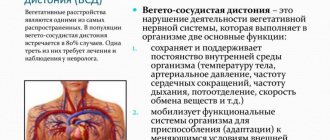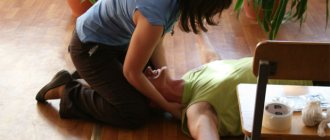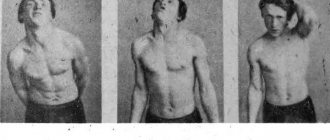Codes of vegetative-vascular dystonia according to ICD-10
Vegetative-vascular dystonia is a disorder of the autonomic nervous system (ANS). Dysfunction of the body occurs. Patients complain of feeling unwell, but examination does not confirm any pathologies. VSD can lead to the development of chronic central nervous system diseases, weakness, and sometimes even disability.
Vegetative-vascular dystonia is a disorder of the autonomic nervous system (ANS).
Autonomic dysfunction and pregnancy
Although pregnancy is a physiological condition, it is then that vegetative-vascular dystonia can manifest itself, occurring latently (hiddenly), because during pregnancy the body is rebuilt and prepares for the birth of a new life. Hormonal levels, the regulator of all pregnancy processes, undergo significant changes. The internal organs are “packed” differently, making room for the ever-expanding uterus. And all this is under the control of the autonomic nervous system, which could not always cope without such a load, but here...
Women suffering from NCD may find out they are pregnant even before the test, because the first sign may be fainting. Vegetative-vascular dysfunction during pregnancy has a more pronounced clinical picture, so pregnancy is more difficult.
Reaction to everything that is “wrong”, tears for every reason, pain in the heart and hysterics, decreased blood pressure, and it’s better not to get into transport... Pregnant women often experience a feeling of lack of air and stuffiness, and those with vegetative-vascular dysfunction even know “ the smell of a fresh breeze."
But everything may not be so bad and you shouldn’t be upset. There have been many cases of disappearance of manifestations of NCD after childbirth. What is the reason for this - either “restoring order” in a woman’s body, or a responsible occupation associated with caring for a baby - is unknown. But patients themselves often note that if they are distracted by important matters, the vegetative-vascular complex recedes.
Top>>>
The concept of vegetative-vascular dystonia
VSD is a disorder that causes insufficient oxygen supply to internal organs and blood vessels. Neurocirculatory dystonia manifests itself during the development of the body at an early age. Men get it less often. The disease is characterized by malfunctions: headaches, improper functioning of organ systems, a disorder of hormonal synthesis, which leads to metabolic disorders.
The causes of the pathology can be:
- intrauterine fetal hypoxia;
- lag in the development of endocrine glands from the growth of internal organs during adolescence;
- development of chronic diseases and hormonal changes in adulthood.
ICD-10 codes for vegetative-vascular dystonia by type
According to the international standard, vegetative-vascular dystonia has code G90.8 (other disorders of the autonomic nervous system). This classification is given to diseases without clear symptoms and visible causes. They cannot be identified as a separate pathology.
Hypertensive type of disorder
It is observed in 75% of the population and affects all age groups. The ICD-10 VSD code for this type is from I10 (primary hypertension) to I15 (secondary hypertension). The functions of the SS system are disrupted. High blood pressure negatively affects the activity of all blood vessels and can damage any system of internal organs.
VSD hypotonic type
Dysfunctions have codes I95.0, I95.1, I95.8, I95.9 (hypotension, idiopathic, orthostatic, primary, unknown etiology). Symptoms of deviations:
- arrhythmia;
- headache;
- decreased physical activity;
- lack of coordination;
- dizziness and fainting;
- change in skin color.
Cervical dystonia
Extrapyramidal central nervous system disorder was coded G24. The appearance and development of the disease is facilitated by hereditary predisposition, head and neck injuries, infections and brain tumors. It is expressed by involuntary movements (swinging and turning) and incorrect head position. The disease is diagnosed in children after 2 months.
The appearance and development of the disease is facilitated by hereditary predisposition, head and neck injuries, infections and brain tumors.
Torsion dystonia
Chronic hyperkinesis with code G24.3 develops as a result of congenital abnormalities or infectious diseases of the nervous system. Accompanied by convulsive muscle contractions and unnatural posture. The progression of dysfunction leads to disability.
Cardiac type of disorder
Diagnostics for cardiac dystonia (code I15.8) records heart rate pathology. Pain and discomfort in the heart are accompanied by increased sweating and readiness to faint. The pathology is caused by psychogenic factors (mental abnormalities, injuries, exhaustion), chronic fatigue, and heavy physical exertion.
Somatoform dysfunction
Violation of the ANS (code F45.3) with signs of organ damage begins to appear in childhood and continues during puberty. Organic changes cannot be detected during examination. Manifestations affect the cardiovascular and genitourinary systems, gastrointestinal tract, and respiratory organs. At the same time they observe:
- problems with urination;
- changes in blood pressure;
- painful digestion;
- heart pain.
Dystonia occurs without pronounced symptoms, changes increase gradually, aggravated against the background of stressful situations and physical strain.
Mixed type of VSD
The neurological disorder code is G24.8. The imbalance causes dysfunction of the respiratory system, gastrointestinal tract, cardiovascular system, and a tendency to hyper- and hypotonic crises. It begins to appear in children after 7 years of age due to intrauterine development disorders, pubertal anomalies, decreased immunity, and chronic infections. Vegetative-vascular dystonia is accompanied by increased anxiety, headaches, and nervousness.
Symptoms of all types of VSD
Symptoms of VSD:
- Significant changes in blood pressure during VSD: critical values at any level are possible.
- Abnormal heart rate, which can cause nosebleeds. In this case, there is cooling of the arms and legs and severe weakness.
- Sleep disturbances at the time of VSD, which are expressed in the appearance of insomnia. Patients try to overcome this condition either with sleeping pills or large doses of alcoholic beverages.
- Frequent, debilitating headaches, which are localized either in the occipital or frontal part of the head.
- Weakness and apathy with VSD, inability to perform any work.
- Excessive nervousness, aggressiveness and irritability.
- Disorders of memory, hearing and vision in VSD.
- Gastrointestinal disorders: constipation or diarrhea, nausea and vomiting.
- Intolerance to cold or heat.
- Panic at the moment of VSD and a feeling of unreasonable fear.
How are VSD codes set for children?
Due to the uncertain etiology and unclear symptoms, it is more difficult to determine the pediatric type of VSD than in adults. The root cause of the syndrome is infections and somatic disorders. To make a reliable diagnosis and determine the ICD-10 code for VSD syndrome for a child, you need to undergo a comprehensive examination by specialists. Need to do:
- Ultrasound of the heart and blood vessels;
- Dopplerography;
- encephalogram;
- ECG;
- detailed blood test.
Based on the research, the neurologist makes a final conclusion and sets the VSD code.
Diagnosis of NCD by mixed type
Although the causes of VSD lie in a person’s head, physical health should not be neglected. If there are signs of dystonia, it is recommended to make a primary diagnosis, which includes:
- General blood and urine analysis.
- Blood chemistry.
- Ultrasound of vital organs.
- ECG.
- Rheoencephalography.
It is necessary to consult a neurologist, endocrinologist, cardiologist, gynecologist (for women), and urologist. Other specialists and studies are assigned as needed.
The main problem of modern doctors is that they do not consider the disease as a single whole of soul and body. Each specialist begins to treat a person exclusively in his own field, which ultimately leads to the prescription of a bunch of useless medications and a lot of wasted nerves and money. Therefore, when identifying NCD, it is recommended to immediately find a competent psychotherapist who can help the patient look at his body as a single system, and at his illness as a single problem, and find the underlying causes of the “failure.”
Basic VSD codes in the ICD
The diagnosis of “vegetative-vascular dystonia” is made only in our country - ICD-10 does not distinguish VSD as a separate disease. Therefore, the alphanumeric designation of the disease is selected based on the prevailing symptoms of VSD and disorders identified during diagnosis.
Vegetative-vascular dystonia is designated by a code in the range G00-G99. These numbers indicate pathologies of the nervous system. For example, a disease can be encrypted:
- G99.0* – autonomic neuropathy with endocrine and metabolic disorders;
- G99.1* – includes other disorders of the autonomic nervous system occurring against the background of concomitant diseases;
- G99.8* – denotes specified disorders of the nervous system in diseases classified in other headings.
What code does the disease NCD correspond to in ICD 10?
Neurocirculatory dystonia is not defined as a disease by the international medical community. The presence of a symptom complex of unknown etiology is recognized. Therefore, the NDC does not have a code according to the ICD 10th edition.
This is explained by the absence of physiological reasons for the present deviations. The pathology has a direct effect on the autonomic nervous system, causing disruptions in the functioning of internal organs and blood circulation.
The symptoms cause significant discomfort to the patient, reduce or completely deprive them of their ability to work.
What are the causes?
Neurocirculatory dystonia began to be seriously studied in the middle of the 20th century. Professor Savitsky N.N. was the first to use the name as a term. The study of the problem was brewing long before this. Manifestations of the pathology were called La Costa syndrome, cardiac neurosis, neurocirculatory asthenia, and so on. Therefore, it was necessary to combine and systematize the symptom complex.
The appearance of abnormalities is observed in different groups of patients, regardless of age or gender. From 5 to 20 different symptoms can be observed at a time in one patient. According to research, the following factors stand out among the reasons:
- Frequent and prolonged stressful situations
- Infectious foci in the body. Caries, sinusitis
- Excessive fatigue of the body
- Violation of the daily routine
- Alcohol consumption, nicotine addiction, drug use
- External exposure to hazardous chemical elements. Working in hazardous industries, living in a polluted area
- Genetic predisposition
- Hormonal imbalance due to age-related changes. Pregnancy, menopause, menopause, puberty
- Personal characteristics of a person
Most often, women suffer from the pathology. They experience stress more severely than men, they take everything “to heart,” and their hormonal levels undergo systematic changes. It can be observed as
adults and in adolescence.
What types are there?
Due to various manifestations, neurocirculatory dystonia is divided into four subgroups. The classification divides pathology according to the type of course:
- Hypertensive
- Hypotonic
- Cardiac
- Mixed
There is a significant difference between the types of progression, manifested by different symptoms. Since the NDC does not have a separate ICD 10 code, doctors are forced to code the closest disease with similar manifestations. Treatment adjustments correspond to the patient’s complaints, as well as the results of biochemical tests and examinations.
Hypertensive type of development
A distinctive feature of hypertensive type NCD is an abrupt increase in blood pressure. The manifestation is accompanied by a hypertensive crisis that occurs at the slightest change in the environment or other factors. Characteristic symptoms for this type:
- Increased heart rate, attacks of tachycardia
- Facial redness
- When the body temperature is elevated, the extremities remain cold
- Recurrent migraine headaches
- Dizziness, sometimes disorientation
- An inexplicable feeling of anxiety. As the condition worsens, panic attacks occur
- Insomnia
- Intense sweating
- Appetite disturbance
The patient may experience a couple of symptoms or all at the same time. The condition worsens during stressful situations.
Since the patient’s condition is characterized by a constant or periodic increase in blood pressure, the doctor diagnoses “Arterial hypertension.”
Considering the severity of the course, the code will be either I10 - primary stage, or I15 - secondary stage.
When prescribing treatment, the doctor takes into account individual characteristics and possible causes of the disorder.
Hypotonic type
The difference between this type and hypertensive type is the low blood pressure. NCD of the hypotonic type is accompanied by symptoms such as:
- Low heart rate, accompanied by attacks of bradycardia
- Headache that is intermittent
- Physical weakness, fatigue. The patient wakes up tired
- Loss of orientation in space, fainting
- Drowsiness, inability to concentrate
- Sudden deterioration due to changes in air pressure
- Memory impairment
- Pale skin
- Cold extremities
The condition may worsen intermittently with mild to moderate severity. Severe is accompanied by constant malaise; sudden changes in body position may cause fainting.
For these manifestations, the diagnosis is code F45.3 or “Somatoform dysfunction of the autonomic nervous system.” As in the previous case, the attending physician takes into account the prevailing symptoms before prescribing treatment.
Cardiac type of development
This variety is more common than others. NCD of the cardiac type is characterized by painful sensations in the chest area. Accompanied by the following symptoms:
- Attacks of tachycardia, bradycardia, alternately replacing each other
- Constant headaches
- Increased irritability, tearfulness
- Insomnia
- Unexplained changes in body temperature
- Fast fatiguability
- Breathing problems
Chest pain can be stabbing, dull or aching in nature. The patient is in a state of inexplicable anxiety, and as the condition worsens, panic attacks appear.
The international classification also classifies this type as somatoform dysfunction with code F45.3 . Considering the fact that the manifestations are periodic, the doctor prescribes additional tests, including a mandatory ECG under stress.
Codes for hypertensive form of dystonia
The hypertensive variant of VSD is characterized by a periodic increase in blood pressure. Hypertension manifests itself:
- discomfort;
- severe headaches;
- nausea;
- loss of strength.
The code is selected based on the development of hypertension:
- Code I10 indicates primary hypertension. The patient has not been diagnosed with organic pathologies that can cause pressure surges.
- Code I15 is used if hypertension in VSD is secondary and develops against the background of some pathology.
The main ICD-10 code may be supplemented by others depending on concomitant VSD diseases.
Treatment
Therapy is selected individually depending on the symptoms. It is necessary to normalize the daily routine, stabilize the emotional state, and do therapeutic exercises. Drug therapy and physical therapy are used to treat symptoms.
Physiotherapeutic treatment
An effective way to treat VSD and other associated pathologies. Physiotherapy is prescribed for outpatient and sanatorium treatment. Types of procedures:
- galvanization;
- electrophoresis;
- electrosleep;
- water treatments (Charcot shower, contrast shower);
- baths (radon, iodine-bromine, hydrogen sulfide);
- magnetic therapy;
- paraffin therapy;
- mud therapy;
- aeroionotherapy.
A course of treatment with physiotherapy can eliminate the manifestations of VSD without the use of medications.
Important! Positive effects in treatment are provided by acupuncture and massage.
Drug therapy
There are no medications that treat VSD. The action of the prescribed drugs is aimed only at eliminating the symptoms. Groups:
- Neuroleptics - reduce irritability, aggressiveness (Ridazine, Risperidone).
- Tranquilizers - used for severe symptoms of nervous system disorders, anxiety, paranoia (Gidazepam, Phenazepam, Diazepam).
- Sleeping pills – to eliminate sleep disturbances (Zopiclone, Donormil).
- Antidepressants - prescribed for a depressed, apathetic state (Paxil, Sydnofen).
- Nootropics – increase concentration and mental performance (Glycine, Actovegin).
- Cerebroangioprotectors - improve blood supply to the brain, relieve headaches (Cavinton, Trental).
- Antioxidants – increase cerebral circulation (succinic acid, Kratal).
- Adaptogens – facilitate acclimatization, accelerate the body’s recovery processes (eleutherococcus, ginseng root).
- Medicines that lower blood pressure are prescribed for hypertensive type VSD (Metoprolol, Bisoprolol).
- Drugs that increase blood pressure are used for the hypotonic type of VSD (Mezaton, Caffeine).
In addition to medications, B vitamins and multivitamin complexes (Neurorubin, Neurobeks) are prescribed.
Codes for hypotensive form of dystonia
Hypotension in dystonia manifests itself:
- loss of strength;
- increased drowsiness;
- yawning;
- tachycardia;
- internal trembling.
During an acute attack of arterial hypotension, the following symptoms appear:
- darkening before the eyes;
- unsteadiness and uncertainty of gait;
- severe dizziness;
- fainting (in severe cases).
The hypotonic type of VSD is most often referred to as code F45.3, which denotes somatoform dysfunction of the autonomic nervous system. The disease is also encrypted with codes:
- I95.0 – idiopathic hypotension;
- I95.1 – orthostatic hypotension that occurs when standing up;
- I95.8 – other types of hypotension;
- I95.9 – hypotension of unspecified etiology.
To select the correct section in the international classification of diseases, the doctor carefully collects anamnesis, determines the mechanism of development of the disease and determines the influence of organic pathologies.
Neurocirculatory dystonia (NCD) is encrypted in the international classification of diseases with code F45.3. This designates somatoform dysfunctions that occur with episodes of heart rhythm disturbances and blood pressure instability.
ICD code for hypertensive type
Sometimes diseases can be caused not only by injury or accidental infection, but also by an incorrect lifestyle. Lack of normal sleep and nutrition, stress and overload - all this has a detrimental effect on our body and can cause the appearance of neurocirculatory dystonia of the hypertensive type.
What are the signs of the disorder, are they recruited into the army with neurocirculatory dystonia, how to treat it correctly - you will find the answers to all these questions in this article.
Medication
Drug therapy is used to eliminate the symptoms of NCD:
- Sedatives and tranquilizers for sleep disturbances and aggressiveness.
- Beta-blockers to remove tachycardia and cardialgia.
- Riboxin, B vitamins to increase heart metabolism.
- Drugs that lower blood pressure.
Other drugs may be prescribed depending on the manifestations of dystonia.
Folk remedies are used in conjunction with the opinion of a doctor. Each of them can reduce the symptoms of the disease, but do not eliminate its cause.
- To eliminate anxiety and aggressiveness, it is recommended to take decoctions of fennel, motherwort, valerian root and chamomile.
- To reduce pain, it is recommended to drink a decoction of nettle, calendula, hop cones, dill and caraway seeds.
- To improve sleep, it is better to use peppermint and lemon balm.
All herbs are brewed according to the instructions on the back of the pharmacy package.
Prevention
Prevention activities are centered around a healthy lifestyle. The simplest recommendations help to avoid dystonia 100%:
- Compliance with the normal regime of work and rest.
- Compliance with the basic rules of proper nutrition.
- Long walks in the fresh air.
- Quitting bad habits.
- Regularly practice your favorite sport.
- Avoiding physical and mental overload.
At critical moments, for example, during hormonal changes, it is necessary to attend preventive examinations to monitor your health. In some situations, for neurocirculatory dystonia, exercise therapy may be prescribed, especially for adolescents.
What is NDC according to ICD 10?
Many people do not know what the ICD 10 NDC code means: F45.3.
In fact, in the ICD - International Classification of Diseases, 10th revision - neurocirculatory dystonia is called somatoform dysfunction of the autonomic nervous system and is recognized as a symptom complex that is caused by an imbalance in the interaction of the sympathetic, parasympathetic and metasympathetic parts of the autonomic nervous system. The same phenomenon is called vegetative-vascular dystonia, autonomic dysfunction.
Source: https://baby-clinic-vozr.ru/voprosy-k-doktoru/kod-po-mkb-ncd-po-gipertonicheskomu-tipu.html
How codes are set for children with VSD
Identification of disease codes according to the ICD in children is no different from encoding diagnoses in adult patients. The development of dystonia in a child may be associated with:
- somatic;
- infectious diseases.
In this case, VSD is a secondary pathology, so the alphanumeric designation of the primary disease is indicated first. Dystonia developing in a child is coded by a pediatric neurologist.
The International Classification of Diseases is a document approved by the World Health Organization. According to generally accepted regulations, certified doctors treating private and public medical institutions are required to use the specified disease encryption standards in their practice.
The use of ICD codes is important not only for studying the characteristics of pathologies and determining the frequency of their detection. Thanks to universal disease coding, patients do not have to worry about how they will communicate their diagnosis to doctors who do not speak their language.
Classification
Depending on the predominant manifestation of neurocirculatory dystonia (disorder of cardiac activity or regulation of blood pressure with a pathological increase or decrease), V. P. Nikitin (1962) and N. N. Savitsky (1964) proposed to distinguish its three types: cardiac, hypertensive and hypotensive. However, not all clinicians consider this classification to reflect the actual number and essence of clinical and pathogenetic variants of neurocirculatory dystonia, and the very possibility of their reflection in the direction of changes in blood pressure is debated. With neurocirculatory dystonia, the complaints of patients with high and low blood pressure often coincide, which indicates the commonality of the leading circulatory disorders, which are not causally related to changes in blood pressure, only integrally reflecting deviations in systemic hemodynamics. The practical use of the classification has shown the significant role of subjective medical interpretations of the types of neurocirculatory dystonia identified in it when establishing and formulating a diagnosis. Thus, the diagnosis of neurocirculatory dystonia of the cardiac type is often made in patients with non-cardiac manifestations of autonomic dysfunction (for example, with complaints of headache, orthostatic disorders) only because the patient does not have blood pressure deviations from the norm. At best, such patients are diagnosed with neurocirculatory dystonia without specifying the type (which contradicts the classification). In addition, the diagnosis of N. Cardiac and hypotensive types (or without specifying the type) is established, as a rule, only if patients have certain complaints (low blood pressure values in themselves are not necessarily a symptom of the disease), while the diagnosis of neurocirculatory dystonia of the hypertensive type in almost half of the cases it is diagnosed only on the basis of recording elevated blood pressure values in the absence of any subjective manifestations of the disease. Classifications of neurocirculatory dystonia with a more detailed division according to the forms of clinical manifestations have certain advantages. For example, Lang (R. Lang, 1989) in his classification of functional cardiovascular disorders, in addition to disorders of blood pressure regulation (hypotensive and hypertensive types) and cardiac activity (in the form of extrasystole, paroxysmal tachycardia, hyperkinetic syndrome), separately considers subjective sensations palpitations or pain in the heart area and additionally identifies syndromes of systemic and regional circulatory disorders: acute cardiovascular collapse (sympathovasal and vagovasal crises), orthostatic syndrome, vasomotor headache. The classification of V. P. Nikitin and N. N. Savitsky, despite the lack of a single principle in designating the types of neurocirculatory dystonia and their clearly insufficient number to reflect all possible variants of the clinical manifestations of this pathological condition, has become widespread and is used as the main one due to its simplicity, as well as because among patients with neurocirculatory dystonia of each type, prevailing groups with a certain commonality of manifestations of the disease and their pathogenesis are still found.
Vegetative-vascular dystonia
Doctors in the post-Soviet space often diagnose such a phenomenon as vegetative-vascular dystonia. In fact, it is not a disease, but a collection of certain symptoms. In ICD-10, vegetative-vascular dystonia does not exist as a separate disorder, but it can be classified as code F 45.3 - “somatoform autonomic dysfunction of the nervous system.” Also, in accordance with the complex of pathologies of the nervous system, it corresponds to the international classifiers G90-G99 - “disorders of the autonomic nervous system.”
In Soviet times, vegetative-vascular dystonia in adolescents was detected in 80% of cases of malaise - today these figures are not much lower
. Vegetative-vascular dystonia in women is observed 3 times more often than in men - on average, about 60% of the female population from 20 to 40 years old “suffers” from this disease.
In Europe and the USA such a diagnosis does not exist. Vegetative-vascular dystonia in simple words means a disorder of the autonomic nervous system. The vegetative department is responsible for the following functions of the body:
- balance of temperature indicators;
- heart rate;
- blood pressure level;
- metabolic rate;
- sweating, which ensures the removal of harmful toxins and excess fluids from the body;
- general adaptability of the body to the conditions of the outside world.
The diagnosis in question in domestic medicine means numerous disorders of a person’s somatic (physical) health.
The impetus to the disease
The question of why someone gets sick and someone doesn’t is inherent in VSD just like other diseases. In the etiology of neurocirculatory dystonia, the main factors can be identified:
- The family nature of the disease, where heredity plays a significant role, however, it should be borne in mind that it is not the disease that is transmitted, but the characteristics of the organism, which is similar to the parent. In the case of vegetative-vascular dystonia, the mother has a greater chance of transmitting a predisposition to the pathology;
- Social environment, which includes living conditions and relationships in the team, affecting the psycho-emotional state;
- Temperament and personality traits;
- History of traumatic brain injury and neuroinfections;
- Hormonal disorders;
- Infectious and allergic diseases;
- Excessive mental and physical stress;
- Change of climatic living conditions.
The combination of several or all factors together leads to the body's reaction to stimuli. This reaction causes the formation of pathological conditions that are manifested by disorders:
- Metabolic processes;
- Innervation of internal organs;
- Works of the gastrointestinal tract;
- In the blood coagulation system;
- Activities of the endocrine system.
The course of the mother's pregnancy, hypoxia and birth trauma also have a negative impact on the state of the autonomic system and can cause vegetative-vascular dystonia in children.
Inconsistency between the systems ultimately leads to a vascular response—their spasm. Thus, the manifestation of neurocirculatory dystonia begins.
Top>>>
Signs of vegetative-vascular dystonia
Vegetative-vascular dystonia in adults and adolescents is manifested by the following fundamental symptoms:
- causeless constant feeling of exhaustion, general weakness and fatigue;
- attacks of fear and panic;
- shortness of breath, attacks of suffocation;
- migraine symptoms;
- pain in the chest;
- changes in health depending on weather conditions;
- dizziness, tinnitus;
- mood swings;
- stomach ache;
- chills, a feeling of coldness in the hands and feet;
- rapid heartbeat, attacks of tachycardia;
- deterioration of memory and thought processes;
- a number of other symptoms.
Kinds
Doctors distinguish the following forms of vegetative-vascular dystonia:
- according to the hypertensive type;
- hypotonic type;
- according to the cardiac type;
- mixed type.
VSD of the hypertensive type. This type of pathology is accompanied by rises in blood pressure to high values. In this regard, headache, dizziness, weakness, flashing “spots” before the eyes, and a feeling of nausea appear. VSD of the hypotonic type. A symptom of this form of pathology is a decrease in blood pressure. Difficult to diagnose due to the general nature of the manifestations. Mixed type VSD is characterized by regular changes in blood pressure from high to low values. Mixed vegetative-vascular dystonia most often appears due to a hereditary predisposition. Clinical symptoms of this form of the disease are panic attacks, increased anxiety, and irritability. VSD of the cardiac type Occurs against the background of other diseases. It manifests itself as pain in the heart area.
Expert opinion
Author:
Tatyana Aleksandrovna Kosova
Head of the Department of Rehabilitation Medicine, neurologist, reflexologist
According to the latest statistics, VSD is diagnosed in 50–70% of the population. At the same time, it is not possible to identify a pattern regarding age and gender. The onset of the disease can occur at any period of life. Among adolescents, vegetative-vascular dystonia is detected in 25–40% of cases.
VSD refers to a complex of pathological symptoms united by a common concept. Diagnosing the disease can be difficult due to the variety of clinical signs. At the Yusupov Hospital, ECG and EchoCG are prescribed for examination. In addition, MRI, CT, 24-hour Holter monitoring, EEG and laboratory tests are used. Based on the results of a comprehensive diagnosis, doctors select the correct therapy. The amount of treatment depends on the severity of symptoms. Depending on the prevailing symptoms, certain groups of drugs are prescribed.
Patients often underestimate the danger of VSD. Without treatment, the disease becomes more complicated. This worsens the patient's condition and requires serious therapy. Therefore, when the first pathological signs appear, it is recommended to consult a doctor. Timely diagnosis and quality treatment are the key to a speedy recovery.
Reasons for the development of VSD
Both adults and children are susceptible to the disease. To date, many reasons have been identified that can provoke the development of vegetative-vascular dystonia. The most common of them are worth considering in more detail.
- The cause of the development of pathology may be a person’s genetic disposition. The risk of developing symptoms of the disease in this case becomes twice as high. The development of VSD can be suspected at an early age. It is expressed by instability of the emotional and mental state, rapid exhaustion of the nervous system.
- Prolonged stress, depressive states, severe emotional shock, psychological trauma - all this can negatively affect a person’s condition and cause unpredictable harm to the body. Usually the body copes with short-term mental overloads on its own and quickly enough. But if stressful situations are prolonged, then this is a clear prerequisite for the development of pathology.
- One of the causes of VSD can be excessive physical activity and an overly active lifestyle. Quite often the disease is diagnosed in people involved in sports at a professional level. The daily work of the body for wear and tear, the desire to achieve maximum results in the shortest possible time will eventually lead to the development of pathology.
- A sedentary lifestyle or too little physical activity can also cause the development of dystonia. With such a slow pace of life, the nervous system also malfunctions, which ultimately leads to pathology.
- Vegetative-vascular dystonia, which develops against the background of other chronic diseases, is also common. The root cause can be: diabetes mellitus, osteochondrosis, asthma, problems with the endocrine system.
- VSD can develop with frequent changes in time zones and climate. Each body reacts differently to such drastic changes and not everyone tolerates them well.
- Focal infections and hormonal changes occurring in the body can also contribute to the development of autonomic disorder.
Symptoms
The severity of subjective and objective manifestations of neurocirculatory dystonia varies widely: from monosymptomatic, often observed in the hypertensive type of neurocirculatory dystonia (increased blood pressure in the absence of complaints), to a detailed picture of a neurosis-like state with an abundance of nonspecific complaints and objective signs of autonomic dysfunction, which may be the same in patients with different types of neurocirculatory dystonia. With a detailed picture of a neurosis-like state, the complaints of patients are dominated by signs of asthenia - increased fatigue, general weakness, irritability, superficial (“sensitive”) sleep, often with vivid dreams, general or local (axillary, palmar) sweating, sometimes unstable low-grade fever. In this case, as a rule, various unpleasant sensations are noted in the heart area (cardialgia, a feeling of emptiness in the chest and) or other parts of the body, headache (irrespective of changes in blood pressure), sometimes dissatisfaction with inhalation, forcing patients to voluntarily increase their breathing, which can lead to to the development of hyperventilation syndrome up to fainting. Regardless of the severity or presence of the listed and other neurosis-like manifestations of the disease in neurocirculatory dystonia, as a rule, signs of dysfunction of the cardiovascular system are revealed. About a third of patients with any type of neurocirculatory dystonia complain of a sensation of palpitations, much less often of interruptions in the heart (in these cases, supraventricular extrasystole is objectively determined), paroxysms of supraventricular tachycardia are extremely rarely observed. Of the subjective manifestations of systemic circulatory disorders, the most common complaints are chilliness (in almost half of patients with the hypotensive type of neurocirculatory dystonia and in about a quarter of cases with other types) and orthostatic disorders (weakness, dizziness, sometimes fainting when quickly getting out of bed or during prolonged standing) , which are observed in about a third of patients with hypotensive type N. And almost half as often in other types. Objectively, patients with complaints of chilliness and orthostatic disorders usually exhibit pallor and decreased skin temperature of the extremities, a tendency to tachycardia at rest and an inadequate increase in heart rate with little physical activity. Pulse filling is often reduced, which is usually combined with a decrease in pulse blood pressure (with any type of neurocirculatory dystonia), and with the hypotensive type also with a decrease in systolic blood pressure. Manifestations of the disease in patients with the hypotensive type are often characterized by pronounced weather dependence; A number of patients have poor tolerance to long breaks in food. In the hypertensive type, complaints are either absent or nonspecific complaints are noted (fatigue, headache, palpitations); objectively, in addition to a transient increase in blood pressure (usually within 150/95 mm), in this type, an increase in the volume of heart sounds and pulsation of the carotid arteries, facial hyperemia, and sometimes an increase in the apex beat of the heart are often detected. Similar symptoms are observed in some patients with the cardiac type, in which tachycardia is often detected, often also sinus (respiratory) arrhythmia, sometimes extrasystole and other arrhythmias, in some cases an increase or decrease in the amplitude of the T wave on the ECG is detected. Left chest pain. Chest pain. Lack of air. Dyspnea. Irritability.
VSD in childhood
The disease in children develops to a greater extent due to excessive emotional stress. Stressful situations, a feeling of constant anxiety, mental stress at school - all this contributes to the appearance of the first symptoms. Also, the cause of VSD can be age-related hormonal changes in the body.
You can determine whether a child is sick by sudden changes in mood, sleep disturbances, decreased activity, and also by rapid fatigue. Also, vegetative-vascular dysfunction may be accompanied by shortness of breath, vomiting, hearing and vision impairment.
Children who lead an inactive lifestyle and are constantly at the computer are more at risk of developing the disease. To avoid the occurrence of vegetative-vascular dystonia, you need to move a lot, play sports, eat right, and also follow a sleep and rest schedule.
Important: A child in a family must live in love and harmony; psychological trauma in childhood can lead to serious complications in the future.
Treatment prescribed by a doctor
It is highly advisable to carry out drug treatment for vegetative-vascular disorders with general health measures and physiotherapy. Therapeutic massage, electrophoresis with sedatives on the collar area, electrosleep and a circular shower will help strengthen the nervous system and give the positive emotions that patients with vegetative-vascular dystonia so need.
What a wonderful procedure - acupuncture. Using it, you can stop taking medications for a long time and feel great only thanks to the annual repetition of acupuncture. Thin gold or platinum needles placed in the neuromuscular bundles will lead to long-term and stable remission, and the disease will recede...
Vitamin therapy and an antioxidant complex (Doctor Theiss, Gerovital, etc.) will be an excellent addition to general strengthening measures.
Medicines for the treatment of neurocirculatory dystonia are taken on the recommendation of a doctor and prescribed by him.
No advice from friends or the Internet is inappropriate here, since drug treatment is prescribed taking into account blood pressure, the presence of cardialgia and the state of the heart rhythm. It is clear that what will help a patient with high blood pressure can have a detrimental effect on the condition of a person with low blood pressure, so it is unlikely that egilok (a beta-blocker) will be indicated for the hypotensive type.
Drugs that regulate heart rate are serious and require special care, so “amateur” in such cases is useless. Often, patients with autonomic disorders are prescribed drugs from the group of tranquilizers - adaptol, afobazole, grandaxin. The herbal preparation Gelarium, which has antidepressant properties, has a remarkable effect. To relieve spasms, bellataminal is often prescribed, which also gives a sedative effect.
Hawthorn, valerian, motherwort – alcoholic infusions of these plants are very familiar to patients with neurocirculatory dystonia; they are constantly stored in the home medicine cabinet and serve as an “ambulance”.
Top>>>
How can traditional medicine help?
The variety of recipes for treating neurocirculatory dystonia with folk remedies is even more striking than the variety of clinical manifestations. The contrasting souls, breathing exercises of Tibetan monks and the Austrian healer Rudolf Breuss are undoubtedly wonderful, but for some reason people prefer the Russian “creation”. A popular drink made from the church “Cahors” and a mixture of garlic, lemon, beet, carrot and radish juices, flavored with natural honey, is passed down “from mouth to mouth and from generation to generation.”
However, to treat VSD with folk remedies, one should not forget about pressure, so traditional healers also recommend different treatments. For example, for high blood pressure, people use infusions of mint and white birch leaves, calendula flowers and dill seeds. Alcohol infusions of magnolia and mistletoe are good for reducing blood pressure.
Strong tea and coffee are not recommended for the hypertensive type of NCD, but in the morning you can drink amazing tea prepared at home:
- Dry blueberries, chokeberries, currants and barberries are taken in equal parts, ground, mixed and consumed, poured with boiling water.
With normal blood pressure levels and a downward trend, prepare infusions of elecampane and immortelle, drink freshly squeezed juices of carrots and rose hips. They say it helps a lot.
Of course, valerian root (you can take it internally, you can take baths), hawthorn, hot milk with honey at night - everyone knows. Such folk remedies are, perhaps, in every home, even where vegetative-vascular disorders are not found.
Top>>>











